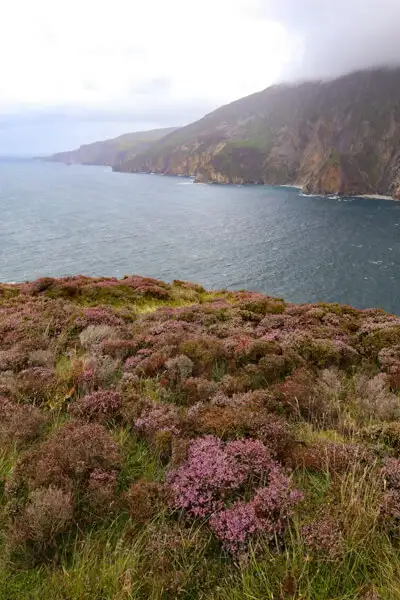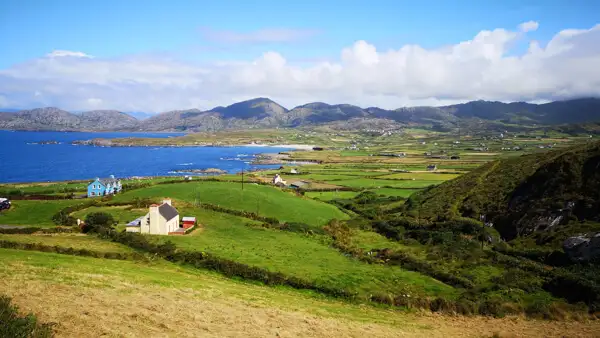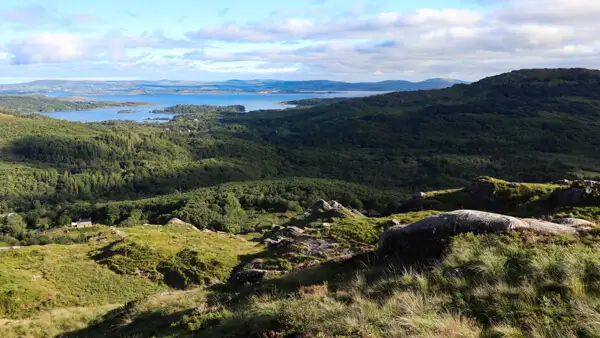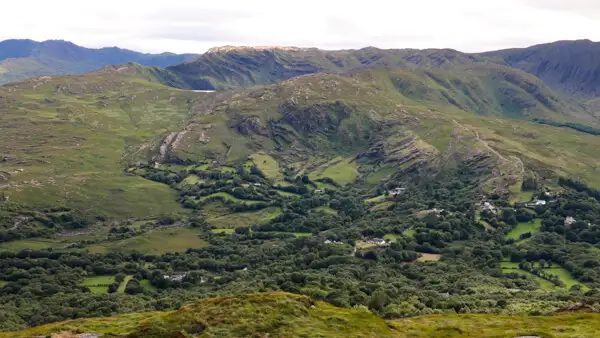If you are planning a holiday in Ireland and would like to do some nice little day hikes on the side, the question of luggage arises at the latest when booking the flight ticket – what do I actually need to take with me for the hikes?
Page Contents (click line to jump the text)

Intro
Below you will find some tried and tested practical tips that should make your choice easier.
How do I know?
My family and I live in Ireland (second home) and we love to do day walks, especially in the Wicklow Mountains and the South East, but also in other parts of Ireland.
Perhaps we’ll first take a look at the walking conditions you might expect, and then at the appropriate equipment:
What’s the hiking weather like in Ireland?
The question comes up again and again, so we’ll answer it right away: No, it doesn’t rain all the time in Ireland, but of course it can rain.
Temperatures in the summer months are usually around 20 degrees Celsius, or slightly above, but there can also be cooler days with only 12-15 degrees and also hot days with up to 29 degrees, especially in July. You can experience bright blue skies with sunshine, but also a lot of cloudy weather, or even drizzle or isolated showers. In summer, the rain is generally less prolonged, but rather ma in small showers.
In spring and autumn it is usually cool, but not really cold. 8-15 degrees Celsius is normal. However, at the beginning of autumn there can be heavy autumn storms with lots of rain – and in autumn rain can also be longer lasting. So it makes sense to check the weather forecast before you pack your bags. A normal weather app is sufficient, e.g. wetter.com.
You have to expect wind all year round in Ireland, it is an island and the sea is not very far away – no matter where you are.

How does the ground become when hiking?
What is that important for? For the choice of footwear – but we’ll get to that in a moment.
You can go for long walks on kilometres of beach – in loose sand. You can also walk on gravel paths and small roads, such as the Wicklow Way.
There are also earthy forest paths that tend to get muddy when it rains and if you walk in the Bog, i.e. in the moorland and upland moors of the mountains, the ground can even get very wet.
Finally, when hillwalking, i.e. hiking in the mountains, there can also be rockier passages with looser stones and boulders. But we are talking about shorter day hikes here, so let’s exclude loose and rough scree.
The choice of hiking boots
I have walked through quite a few hiking boots and currently have three pairs in use: a pair of light and relatively soft textile hiking boots, a pair of medium-strength trekking boots and a pair of very sturdy alpine mountain boots – all with waterproof membranes. I also run in jogging shoes or other sturdy shoes with lightly profiled soles.
What can I recommend to you now?
For easy day hikes, good weather and soft ground or well-paved paths, a shoe that is as light as possible is simply pleasant. Jogging shoes have a rather thin sole at the front, which is why they are not well suited to coarser gravel paths, but sturdier walking shoes or light hiking shoes are perfectly adequate.
As soon as the weather gets wet and you are walking in wooded areas or in the Bog (high moorland and heath on the mountains), I recommend an ankle-high, rather soft textile hiking boot with a waterproof membrane. These will keep your feet dry even in bad weather, offer a bit more stability, but are still very comfortable to walk in. Why textile and not leather? They are usually lighter and softer and easy to wash off – practical for travelling.

For hillwaking, they can be a bit sturdier (trekking boots), but that’s the subject of another article.
Socks: These form a system together with the shoes, but are often “overlooked”: good hiking socks or sports socks made of synthetic material, wool, or wool-synthetic mix. Please do not wear your beloved tennis socks; as soon as they get wet, they get cold, may wrinkle and contribute to blisters.
Hiking jacket and rainwear
A waterproof jacket should generally be included. Not necessarily, for a 2 hour walk on the beach in persistently sunny weather, but whenever it might rain…., or the tour gets longer.
You can either use a good membrane jacket, or wear a more breathable softshell jacket and pack a lightweight waterproof (non-breathable) jacket in your rucksack. Both solutions are also good if it doesn’t rain but gets very windy – not uncommon in Ireland….
Breathable waterproof trousers are also a good investment if you plan to hike in bad weather (or whatever the weather), or run multi-day trails.
The hiking trousers
I’ve run in jeans often enough, but I know when the limit is reached: cotton gets wet quickly and dries very slowly. Wet cotton insulates very poorly and if it’s windy, you can get very uncomfortably cold very quickly.
As soon as I expect rain or run a little longer or higher, I put on quick-drying hiking trousers made of synthetic material.
The insulation layers
As always when hiking, the onion system is also very helpful in Ireland: It is better to have several thin layers that you can combine than one thick layer (and then it is warmer than expected…).
The base layer is more important than many people think: good synthetic sports underwear actually helps to wick sweat away from the body and dries quickly, so it helps to keep you warm and comfortable during more strenuous activities. Short underwear in warm temperatures, long underwear in cool temperatures. Leggings and sports T-shirts are also good if you don’t want to buy hiking underwear.
If you have chosen a good base layer and a good jacket and trousers, you don’t need much as a second layer in between: A thin fleece shirt or two to combine should be enough for most of the year.
The luggage for the day
A small daypack is recommended. 15-20 litres is quite sufficient. It should sit comfortably on your back and not hang like a ball on your hump, then you are already well equipped. Higher-quality backpacks have good back padding or a carrying frame, but for smaller trips a simpler model is usually enough.
If the rucksack doesn’t have a rain cover, you should take one or more waterproof inner panniers, or at least a large plastic bag, so that the contents don’t get wet at the first rain.

I always carry a water bottle (or two) with me, and I would recommend it – the trip can always take longer and the streams on your way are not always clear, but sometimes boggy. In addition, a small snack makes a lot of sense to keep the blood sugar level from dropping too low: Some fruit, a sandwhich or a muesli bar will do wonders to keep your spirits high and your feet running.
In summer, I also always carry sunglasses with me, as well as sunscreen, especially on the mountain or by the sea.
Mosquitoes or midges are not a big issue in Ireland, unlike in the Scottish Highlands. But if you are sensitive and prefer to take a small tube of mosquito repellent, it doesn’t hurt.
For safety – sprained ankle, now what: Start your tour with a fully charged mobile phone and if you are travelling alone and for a longer time and still want to take lots of photos or videos on the way, perhaps also think about a powerbank for recharging. The emergency number is 112 in Ireland and 999 in Northern Ireland (also works in Ireland).
You won’t have mobile phone coverage in every valley. So it doesn’t hurt to take a map with you. You can also just print out a section of Google Maps (terrain or satellite view) and take it with you.
A small first-aid kit will help with injuries, blister plasters are also very useful, especially for new shoes. If you are out late, a small torch or headlamp (no, not the mobile phone torch) is also a good idea.
Have I forgotten anything else?
But yes: I wish you a lot of fun on your hikes in Ireland!!!
More interesting articles for you
ROUND TRIP IN THE NORTH OF IRELAND WITH DAY HIKES – 8 GREAT IDEAS FOR YOU
SOUTHERN IRELAND ROUND TRIP WITH DAY HIKES – 9 GREAT IDEAS FOR YOU
22 TIPS FOR YOUR HIKING VACATION IN IRELAND
HIKING WITHOUT CARRYING ALL THE LUGGAGE IN IRELAND – WHAT ARE THE OPTIONS?
Photo credits cover photo: Boots in the sand, photo by Ulrich Knüppel-Gertberg (www.irland-insider.de, www.ireland-insider.com)